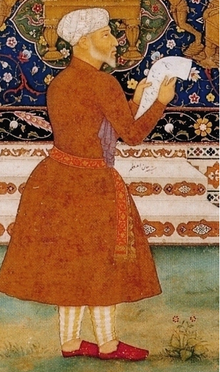Mirza Aziz Koka
| Mirza Aziz Kokah | |
|---|---|
 | |
| Personal details | |
| Born | 1542 |
| Died | 1624 (aged 81-82) Agra Fort, Mughal Empire, now India |
| Children | Habiba Banu Begum |
| Parent(s) | Ataga Khan (father) Jija Anga (mother) |
Mirzā `Azīz Kokah (Persian: میرزا عزیز کوکه; c. 1542 – c. 1624), also known as Kokaltāsh (Persian: کوکلتاش) and by his sobriquet Khān-i-A`zam (Persian: خان اعظم The Greatest Khan), was the foster brother of Akbar, who remained one of the leading nobles at the courts of the Mughal emperors Akbar and Jahangir.[1] He was also the Subahdar, governor of the Subah (province) of Gujarat.[2]
Biography[edit]
Early life[edit]
He was the son of Shams ud-Din Ataga Khan, the Prime Minister of Akbar, and Akbar's wet-nurse, Jiji Anga, hence his Turkish sobriquet “Koka” or “foster-brother.” [3][4] Ataga Khan was murdered by Adham Khan, the jealous son of Maham Anga, another of Akbar's wet-nurses, in 1562. Thereafter, Aziz Koka built his father's tomb next to Nizamuddin Auliya in Delhi in 1566-67. Adham Khan, on the other hand, was executed on the orders of Akbar.[5]
After Akbar conquered Gujarat, he made Aziz Koka the governor of the new province. In 1573, the Gujaratis rebelled and besieged Aziz Koka in Ahmedabad. But he defended the city until Akbar's army came to his relieve. In 1579, he was made governor of Bihar and ordered to quell a rebellion in Bengal. however, he did not take action until the next year, when the rebels began to take Bihar as well. He was similarly reluctant when ordered to conquests in the Deccan in 1586.
Akbar was very lenient to Aziz Koka, his foster-brother and childhood playmate. Nevertheless, Aziz Koka did not obey Akbar, his emperor, readily. He was especially opposed to Akbar's law to brand all horses, and could not accept prostration in Akbar's new court ritual. When Aziz Koka was summoned to court in 1592, he went on pilgrimage to Mecca instead. There he spent much money to pious causes for a year and a half, until Akbar forgave him, and restored him in his positions.[6]
Later life[edit]
During the rule of Jahangir, however, he lost many positions, as he along with Raja Man Singh I supported the rebellion of Khusrau Mirza, the eldest son of Jahangir (one of his daughters was Khusrau's wife). Khusrau's rebellion was crushed in 1606. He was first blinded and then imprisoned. Though Jahangir never found any direct evidence against Man Singh and Aziz Koka to have them executed, he however took away much of their powers, and chided them in the Jahangirnama. Later in life, Aziz Koka regained his position, but his clan could never regain the royal patronage, as they enjoyed during his father's lifetime.[7]
His daughter, Habiba Banu Begum was married to the fourth son of Akbar, Mughal prince Sultan Murad Mirza in 1587; and had two sons, Rustam Mirza (b. 1588) and Alam Mirza (b. 1590).[citation needed]
He built his tomb, Chausath Khamba, literally 64 pillars, during 1623–24, near the Nizamuddin Dargah shrine complex in Delhi.[8]
Notes[edit]
- ↑ Lefèvre, Corinne. "ʿAzīz Koka, Mirzā ." Encyclopaedia of Islam, THREE. Edited by: Gudrun Krämer, Denis Matringe, John Nawas, Everett Rowson. Brill Online, 2013. Reference. 14 August 2013.
- ↑ Kumkum Chatterjee; Clement Hawes (2008). Europe Observed: Multiple Gazes in Early Modern Encounters. Associated University Presse. pp. 52–. ISBN 978-0-8387-5694-2. Retrieved 16 August 2013.
- ↑ Harbans Mukhia (2004). The Mughals of India. Wiley India Pvt. Limited. pp. 55–. ISBN 978-81-265-1877-7. Retrieved 16 August 2013.
- ↑ Burton-Page, J.. "Mīrzā ʿAzīz “Kōka”." Encyclopaedia of Islam, Second Edition. Edited by: P. Bearman, Th. Bianquis, C.E. Bosworth, E. van Donzel, W.P. Heinrichs. Brill Online, 2013. Reference. 16 August 2013.
- ↑ Catherine B. Asher (24 September 1992). Architecture of Mughal India. Cambridge University Press. pp. 43–. ISBN 978-0-521-26728-1. Retrieved 15 August 2013.
- ↑ Nawwāb Ṣamṣāmuddaula Shāh Nawāz Khān and ‘Abdul Ḥayy: The Maāthir ul-Umarā, translated into English by H. Beveridge, revised, annotated and completed by Baini Prashad, Kolkata: Asiatic Society, 1941, rep. 2003, p. 319-334.
- ↑ Faruqui, p. 227
- ↑ "Mirza 'Aziz Kotaltash Tomb". ArchNet Digital Library. Archived from the original on 2012-12-10. Retrieved 2013-08-15.
Bibliography[edit]
- Munis D. Faruqui (27 August 2012). The Princes of the Mughal Empire, 1504-1719. Cambridge University Press. ISBN 978-1-107-02217-1. Retrieved 15 August 2013.
